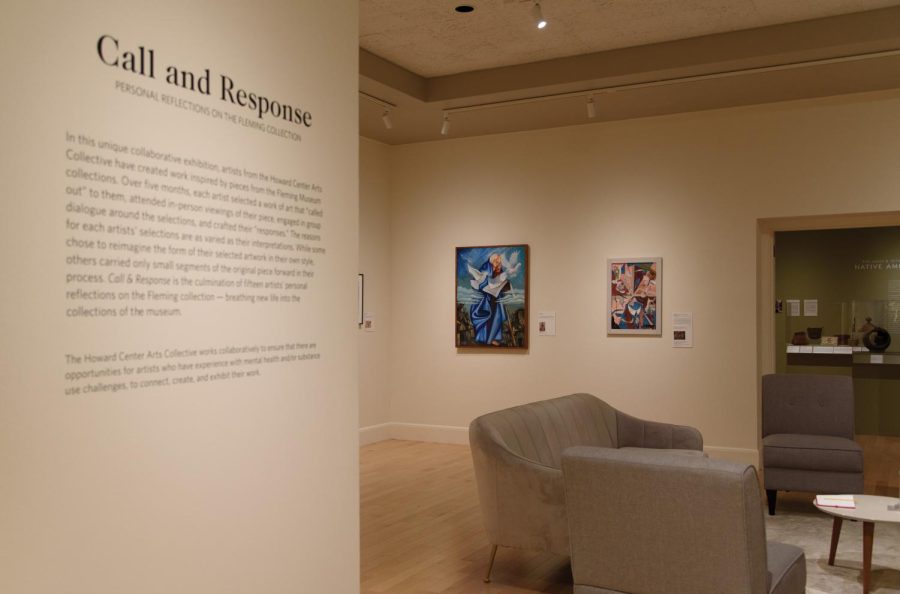Community curation: A new direction for the Fleming
The “Call and Response” exhibit at the Fleming Museum Nov. 29. The seating in the room creates a storytelling space.
November 30, 2022
Of all the institutions affected by COVID-19, few were more radically impacted than museums, with nearly 90% closing their doors, according to a May 2020 UNESCO article.
Among the tangible shifts caused by COVID-19, such as the closing of doors and the shifting of collections online, the pandemic has also sparked potent ideological changes within many museums.
One such museum which has been particularly impacted by these shifts is the University of Vermont’s Fleming Museum. Margaret Tamulonis, manager of collections and exhibitions at the Fleming Museum, spoke about how COVID-19, along with racial injustices in America, sparked an ideological reckoning within the museum.
“We began to re-question our relationship with the University and our greater community,” Tamulonis said. “The museum wanted to be more open and flexible with the community that supports it.”
Since its full reopening in January 2022, one of the Flemings’ attempts to connect with its community has taken the form of a collaboration with the Howard Arts Center Collective.
The Howard Arts Center Collective is a program within the Howard Center, a nonprofit organization located in Burlington that provides professional crisis services for children and adults, according to their mission statement.
The Arts Center Collective works collaboratively with artists who have experiences with mental health and/or substance use challenges to ensure they have opportunities, according to their website.
Together, the collective and the museum created an exhibition titled “Call and Response: Personal Reflections on the Fleming Collection.” Though it is relatively small in size, spanning only 16 items, this exhibition represents a significant shift for the Fleming, challenging long-standing traditions at the museum.
Instead of a sole curator selecting items for the exhibit, the Fleming Museum invited 16 artists from the Howard Arts Center Collective to explore the museum’s more than 20,000-piece collection archive. During their search, each artist picked an item from the collection that inspired them.
These items ranged from a small black box once used to hold lucky crickets from 1870 to a rough sketch of a hospital operating room from the 1930s.
After selecting their pieces, the artists responded to them by creating their own works of art that reflected or challenged their chosen items. These reaction pieces are what compose the collection of works displayed in the “Call and Response” exhibit.
This unique method puts the power of creating the exhibit mainly on the artists, emphasizing the community element of curating, something the Fleming has begun to cherish, said Alice Boone, curator of education and public programs at the Fleming Museum.
“We are starting to see the work of curating a show as something that’s collective and belongs to a group of people rather than a single curator,” Boone said.
This collective method emphasizes greater community interaction and makes the galleries more impactful, Boone said.
“Building relationships is how you make art that resonates with people,” she said. “It allows people to see the human element of the art and truly connect with it.”
Not only has this method fostered a greater connection between the museum and the Burlington community, but first-year Kael Fitzpatrick, a Fleming Museum visitor, said it has also resulted in one of the most diverse gallery collections he’s ever seen.
“For being such a small space, there was a lot to see,” Fitzpatrick said. “There was a lot of variation in the art. It was cool to have so many styles in one space, and it made every piece feel unique.”
First-year Alex Tallo, another visitor to the exhibition, said the only clear throughline between all the pieces is the powerful emotional impact.
“Everything feels as if it’s saying something,” Tallo said. “I feel like you can feel the artists’ emotions just by looking at the art.”
Another unique aspect of the exhibit is its structure. In the center of the exhibit is a collection of couches and chairs that form a storytelling space, Tamulonis said.
“An artist’s life can be so solitary,” Tamulonis said. “The purpose of the couches is to foster a meeting space where both artists and our greater community can express themselves.”
Boone has led numerous successful discussions among UVM students within this storytelling space, she said.
“We’ve had about 35 different classes have conversations in ‘Call and Response,'” Boone said. “Among them, we’ve had a variety of disciplines like studio art, art history, history, psychology and many others who all find use in the space.”
Fitzpatrick and Tallo are plant biology and art majors, respectively, but each had a unique and potent response to the exhibit. Fitzpatrick walked away feeling inspired whereas Tallo’s immediate reaction was to go and reflect on some of his own art.
“Call and Response: Personal Reflections on the Fleming Collection” closes Dec. 9. With final exams looming, it may be challenging to find time for anything outside of studious study, but the exhibit is worth seeing if you can make the time.
The Howard Arts Center Collective artists are all unbelievably talented, and each produced a potent and stunning work of art.
If none of that can convince you, at the very least, the couches in the gallery are unbelievably comfortable.







